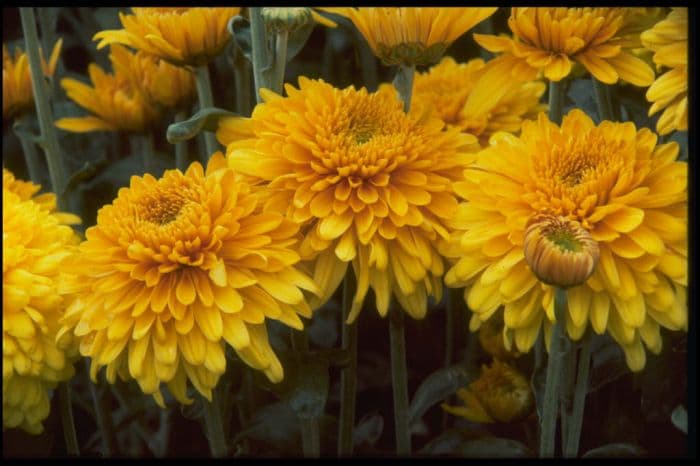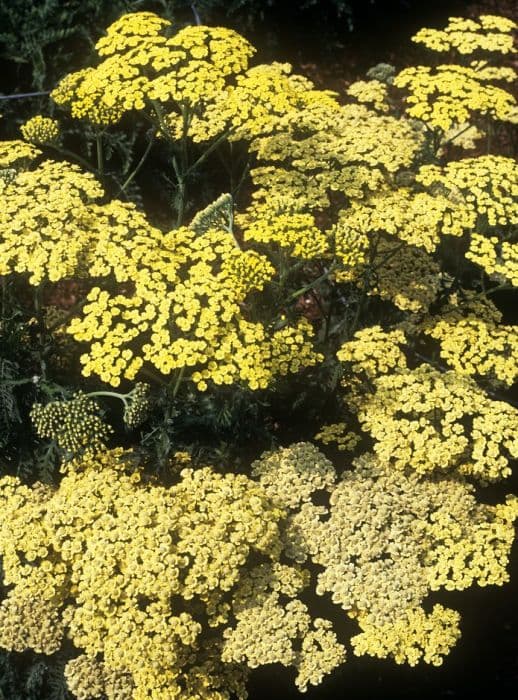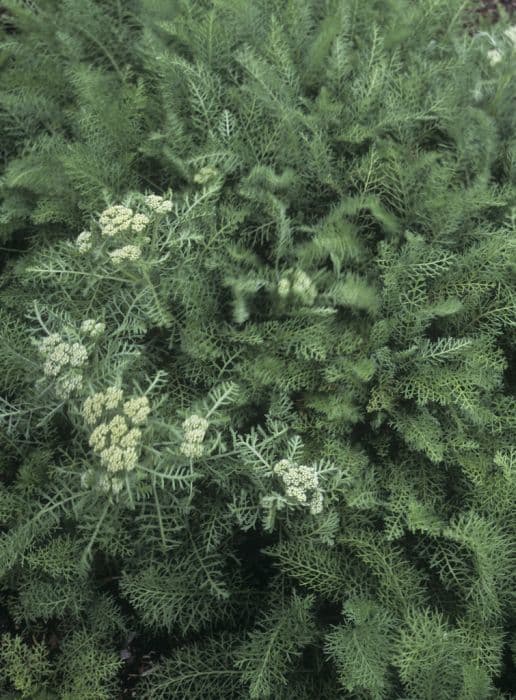Chrysanthemum Chrysanthemum 'Fleet Margaret' (29c)

ABOUT
Chrysanthemum 'Fleet Margaret' is a beautiful, ornamental flower known for its vibrant and attractive blooms. This type of chrysanthemum, commonly referred to as just 'mums', typically features a bushy, dense growth habit with dark green leaves that provide a lush backdrop for its floral display. The leaves are typically deeply lobed with a slightly serrated edge, giving them a rich texture. The flowers of 'Fleet Margaret' are the highlight of the plant, often appearing in a stunning shade of pink. The blooms are characterized by numerous layered petals that create a full, almost spherical shape similar to a pom-pom. The petals sometimes exhibit a lighter or darker tint at the tips, adding a delightful two-tone effect to the flower heads. The vivid flowers create a striking contrast against the dark foliage, making them stand out in any garden setting. These chrysanthemums typically flower in the later months of the year, bringing a splash of color to the garden when many other plants are fading. The 'Fleet Margaret' is often celebrated for its longevity in bloom, offering an extended period of visual enjoyment. Overall, the 'Fleet Margaret' chrysanthemum is treasured for its ornate blossoms and serves as a popular choice for cut flower arrangements, borders, and decorative outdoor displays due to its delightful and eye-catching appearance.
About this plant
 Names
NamesFamily
Asteraceae
Synonyms
Fleet Margaret Chrysanthemum, Hardy Mum, Garden Mum
Common names
Dendranthema 'Fleet Margaret', Chrysanthemum morifolium 'Fleet Margaret'.
 Toxicity
ToxicityTo humans
Generally, chrysanthemums are not considered highly toxic to humans. However, they can cause dermatitis in some individuals when the skin comes into contact with the plant's sap. If ingested, parts of the chrysanthemum might cause mild gastrointestinal upset, including diarrhea, nausea, and vomiting. It is always best to avoid eating ornamental plants due to potential adverse effects.
To pets
Chrysanthemums are toxic to pets, such as dogs and cats. They contain compounds that can cause vomiting, diarrhea, hypersalivation, incoordination, and dermatitis. In more severe cases, ingestion can lead to signs of toxicity involving the nervous system. If you suspect your pet has ingested part of a chrysanthemum, you should contact your veterinarian immediately.
 Characteristics
CharacteristicsLife cycle
Perennials
Foliage type
Deciduous
Color of leaves
Green
Flower color
Pink
Height
1-2 feet (0.3-0.6 meters)
Spread
1-3 feet (0.3-0.9 meters)
Plant type
Herb
Hardiness zones
5
Native area
Asia
Benefits
 General Benefits
General Benefits- Attracts pollinators: The Chrysanthemum 'Fleet Margaret' (29c) is known to attract beneficial insects like bees and butterflies, which are crucial for pollination.
- Aesthetic appeal: With its vibrant colors and full blooms, this chrysanthemum variety adds beauty and ornamental value to gardens and landscapes.
- Seasonal Interest: It provides a splash of color in the fall when many other plants are starting to decline.
- Drought tolerance: Once established, it can tolerate periods of low water, making it suitable for xeriscaping and water-wise gardening.
- Easy to grow: This plant is known to be hardy and low maintenance, adapting to a wide range of soils and requiring minimal care.
- Versatility: It can be used in borders, container gardens, and as cut flowers for indoor decoration.
- Cold hardiness: It can withstand cooler temperatures and is suitable for growing in regions with cold winters.
 Medical Properties
Medical PropertiesThis plant is not used for medical purposes.
 Air-purifying Qualities
Air-purifying QualitiesThis plant is not specifically known for air purifying qualities.
 Other Uses
Other Uses- Textile Dyeing: The petals of Chrysanthemum can be used to create a natural yellow dye for textiles, offering an eco-friendly alternative to synthetic dyes.
- Photography: Petals of Chrysanthemum may be utilized in photogram work, where they can be placed on photosensitive paper to create unique prints when exposed to light.
- Bookmarks: Dried Chrysanthemum petals can be laminated within paper or clear film to make decorative and fragrant bookmarks.
- Crafting Confetti: Dried petals of the Chrysanthemum can be used as biodegradable confetti for weddings or other celebrations.
- Scented Potpourri: The petals and leaves, when dried, can add a pleasant fragrance to homemade potpourri mixes.
- Natural Insect Repellent: Chrysanthemum can be planted in gardens to repel certain insects naturally due to its natural insecticidal properties.
- Art Supplies: Chrysanthemum petals can be used to create unique textures and patterns in mixed media art and collages.
- Soap Making: Petals can be embedded in glycerin soaps for decoration and to add a mild natural fragrance.
- Candle Decoration: Chrysanthemum petals can be incorporated into candle wax or attached to the outside of a candle for an ornate appearance.
- Gourmet Cuisine: Some chefs use the petals as an edible decoration to add a touch of elegance to plates and dishes.
Interesting Facts
 Feng Shui
Feng ShuiChrysanthemums are used in Feng Shui for bringing happiness and laughter into the home, symbolizing longevity and joy. Place these flowers in the living room or in other areas where you wish to boost positive energy and create a welcoming atmosphere.
 Zodiac Sign Compitability
Zodiac Sign CompitabilityChrysanthemums are not used in astrology practice.
 Plant Symbolism
Plant Symbolism- Longevity: The chrysanthemum is often associated with long life and health, stemming from its extensive use in traditional medicine and its significance in Asian cultures.
- Rebirth and Renewal: Because chrysanthemums bloom in the fall, they symbolize the idea of rebirth and the cycle of life, as many plants become dormant during this time.
- Loyalty and Honor: In several cultures, the chrysanthemum is a symbol of loyalty and devotion, perhaps due to its ability to endure and bloom late into the season.
- Happiness and Joy: With their bright and cheerful appearance, chrysanthemums often represent happiness and joy in flower language.
- Nobility: In many Eastern cultures, the chrysanthemum is of noble stature and associated with aristocracy and elegance.
 Water
WaterMums should be watered regularly, about once a week, ensuring the soil doesn't dry out completely but also isn't waterlogged. It's crucial to water mums deeply, so the water reaches the root system; give them approximately 1 gallon of water per watering session. In hotter weather or if you notice the leaves wilting, increase the frequency of watering. It's always best to water early in the day, at the base of the plant, to avoid wetting the foliage which can lead to fungal diseases.
 Light
LightMums thrive in full sun conditions, which means they need at least 6 hours of direct sunlight a day. Place the Chrysanthemum 'Fleet Margaret' in a spot where it will receive ample morning light and some protection from the intense afternoon sun, especially in hotter regions to prevent scorching.
 Temperature
TemperatureThe ideal temperature range for Chrysanthemum 'Fleet Margaret' is between 60 to 70 degrees Fahrenheit. They can tolerate a minimum temperature of 32 degrees Fahrenheit and can survive up to around 90 degrees Fahrenheit, but the foliage might suffer at these extremes. To promote healthy growth and flowering, keeping them at the ideal temperature range is best.
 Pruning
PruningPruning the Chrysanthemum 'Fleet Margaret' helps maintain its shape, encourages bushier growth, and promotes more blooms. Prune in the early spring as new growth appears, cutting back the old stems to about 4-6 inches. Additionally, pinch back the growing tips through the spring to create a denser plant. The best time for heavy pruning is just after the bloom cycle when flowers have faded.
 Cleaning
CleaningAs needed
 Soil
SoilMums thrive best in well-draining, fertile soil with a pH between 6.5 and 6.7. A good soil mix for the Chrysanthemum 'Fleet Margaret' can include equal parts of garden soil, peat moss, and perlite or sand to ensure proper drainage and aeration while retaining some moisture and nutrients.
 Repotting
RepottingMums should be repotted every one to two years to replenish soil nutrients and prevent root crowding. Chrysanthemum 'Fleet Margaret' should be repotted after blooming or in the spring before the onset of new growth.
 Humidity & Misting
Humidity & MistingChrysanthemum 'Fleet Margaret' prefers moderate humidity levels. Aim for a humidity level around 40-60% for optimal growth and flower production.
 Suitable locations
Suitable locationsIndoor
Place in bright indirect light, moderate water, and ensure good air flow.
Outdoor
Plant in full sun to partial shade with well-draining soil.
Hardiness zone
5-9 USDA
 Life cycle
Life cycleChrysanthemum 'Fleet Margaret', commonly known as garden mum, begins its life cycle as a seed or cutting. When the seed germinates or the cutting roots, the plant enters the vegetative stage, growing leaves and stems. As it matures, it starts to develop buds during the early summer. These buds will bloom in late summer to fall, displaying the plant's characteristic flowers—often to encourage pollination by insects. After flowering, the plant sets seed if conditions are conducive. In some climates, the garden mum may die back after blooming and enter dormancy in winter, to re-emerge in spring, or it may be grown as an annual and complete its life cycle within one growing season.
 Propogation
PropogationPropogation time
Spring-Early Summer
The most popular method of propagating the Chrysanthemum 'Fleet Margaret' is through cuttings. This is typically done in late spring to early summer when the plant is actively growing. Gardeners select healthy, non-flowering shoots and cut a 4 to 6 inch (10 to 15 cm) section. The lower leaves are removed, and the cut end may be dipped in rooting hormone before being placed in a well-draining soil mix. The cutting should be kept moist but not soggy, and in a warm location with indirect sunlight. In time, the cutting will develop roots and can be transplanted into a separate pot or garden location to grow into a new plant.









